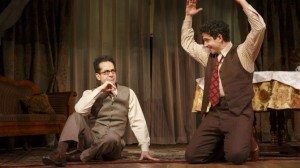

How did Moss Hart go from being a poor immigrant to the toast of Broadway? By collaborating with comic playwright George S. Kaufman, by directing the legendary “My Fair Lady”, by penning the screenplay for “A Star is Born”, and by writing a memoir of his early years – “Act One” – that is still considered one of the best theater autobiographies ever penned.
James Lapine, a Pulitzer winner for his collaboration with Stephen Sondheim on “Sunday in the Park with George”, has adapted Hart’s memoir into a play, which made its Broadway debut Thursday night, April 17, at Lincoln Center Theater’s Vivian Beaumont house.
Andrea Martin, beloved for her Second City TV days and in-demand thanks to her “Pippin” Tony win, is in the cast, as are Tony Shalhoub (of “Monk” fame) as Kaufman, Tony-winner Chuck Cooper (“The Life”) and Santino Fontana (late of “Cinderella”) as young Moss. Staged by the author, “Act One” previews March 20 for a run through June 15.
So do the New York critics think Lapine was right to raise a curtain on a theatrical “Act One”?
Writing for the Chicago Tribune, Chris Jones bemoans the gap between Hart’s book and Lapine’s result. He calls the show “long, laborious” and “hackneyed”, going so far as to say that if Hart, himself, had done the adaptation, he would have pushed for “many more truths along with many more laughs.” Jones also gets whiplash from the show’s shunting back and forth between Hart’s impoverished home life and the glamorous world he enters once he meets Kaufman.
Variety’s Marilyn Stasio is almost as negative, noting that “winning star turns by Santino Fontana and Tony Shalhoub” can’t save a show that’s “verbose, unwieldy” and “overacted.” She also complains about the show’s two narrators (one too many in “a production lumbered with too many of these, too many of those, and much too much of just about everything else.”) On the plus side, she does like one scene in act two wherein we see the effect of Kaufman and Hart rewriting a scene for vaudevillians in the midst of performing.
Much happier with the show (and certainly happier than he was with “Of Mice and Men” the night before), the New York Times’ Ben Brantley sees Shalhoub and Fontana carrying the “overblown” show, though even the show itself “brims contagiously with the ineffable, irrational and irrefutable passion for that endangered religion called the Theater.”
Even more laudatory is the Wall Street Journal’s Terry Teachout, who says Lapine’s labors have resulted in “a thrillingly well-staged play that runs for two hours and 40 minutes but feels much shorter… It has the open-hearted impact of a melodrama – one that has the advantage of being true.” Teachout applaudes the cast and Lapine’s book, wherein “every piece of the story is shown rather than told.”
David Rooney, of The Hollywood Reporter, feels the opposite. Despite Beowulf Boritt’s “ingenious” set design, the show is a “botched” attempt to bring Hart’s book to onstage life. “`Act One,’ he writes, “remains entirely imprisoned on the page form its earliest scenes… As soon as you appoint…dueling narrator chores, you’re in trouble.” He’s also not a fan of Andrea Martin’s turn as Aunt Kate, who is likably smitten with the theater in the book but is here shown as a “selfish snob.”
Also disappointed in the play is Newsday’s Linda Winer, who decries “Act One’s” dispiriting lack of drama… [It’s] almost three hours of busy, flatline narrative. This happens and then that happens.” She closes her review noting, “What will be remembered from this memory play…is Beowulf Boritt's splendid, cunning turntable set... If only the story could spin like that.”
Mustering *** for the show, Daily News critic Joe Dziemianowicz finds the first act better than the “long-winded” second. “The odd-couple dynamic between the writers is fun,” he opines, but the show “never reveals what made Hart special.”
Giving the play only **, the New York Post’s Elisabeth Vincentelli calls the show a snooze, filled with “fussiness and a lack of focus.” She concludes, “If you think watching paint dry is boring, try watching two men edit a long-forgotten play.”
“It could be said Lapine's play is the kind for which the adjective `sprawling’ was invented,” writes Huffington Post reviewer David Finkle. Yet he’s such a fan of the material that he’s happy to “leave it all in,” especially with such an “impressive” cast at hand. Ultimately, “everything that Lapine has worked in to tell the heart-felt and heart-stirring tale feels right.”
Giving the show a B-minus grade, Entertainment Week’s Melissa Rose Bernardo calls “Act One” “lovingly presented but largely listless” with “an unnecessarily cumbersome two-narrator approach.” Like some of the other reviewers, she finds the second act writing of `Once in a Lifetime’ long and repetitious. How can a show “that spends so much time dissecting and trying to perfect another show be so unaware of its own imperfections?” she sighs.
NorthJersey.com’s Robert Feldberg concurs, griping that the lengthy show “on an epically clumsy, revolving, three-story set” is over-crammed, even as “Hart himself never comes into strong focus.” In fact, the only thing worth watching is Tony Shalhoub’s “inspired, very funny portrayal of Kaufman.”
OVERALL:
The general consensus here is mixed-to-negative, with most critics wishing director Lapine had sent playwright Lapine back to the drawing board to cut, reshape and focus the piece. A mostly positive review in the Times and a rave in the Wall Street Journal are unlikely to offset the feeling that “Act One” could have used the real Moss Hart’s red pencil. Surviving the brickbats are leads Santino Fontana and especially Tony Shalhoub, who’s a cinch for a Tony nomination.